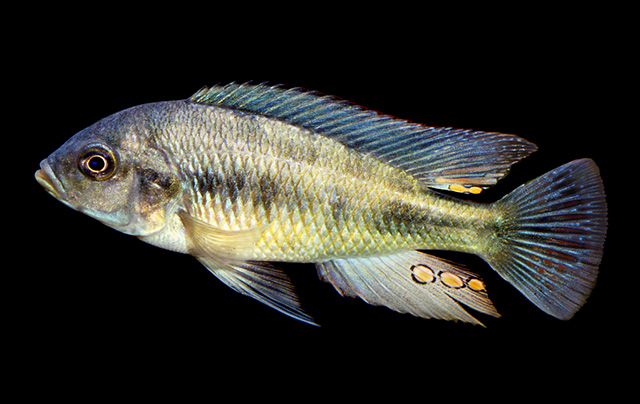|
Dorsal spines (total): 15-16; Dorsal soft rays (total): 8-10; Anal spines: 3-3; Anal soft rays: 7-10; Vertebrae: 29-29. Diagnosis: relatively small species, moderately elongate (body depth 2.6-3.0 times in SL); dorsal head profile relatively steep, strongly convex dorsally of large eye (eye diameter about 4.0 times in HL, 1.2 times in snout length and 0.96 times in interorbital space); lips moderately but more or less equally thickened; outer teeth strong with recurved tips, procumbent, especially in lower jaw; usually anteriorly 3-6 rows of inner teeth in upper jaw, rows not very distinct; haplochromine "head mask" very weakly developed, hardly visible in not sexually active males; dominant males bluish with greenish hue; prominent dark grey longitudinal band from eye to caudal peduncle, interrupted above anterior half of anal fin; second dark grey longitudinal band along upper lateral line; 6-8 weakly expressed vertical bars about width of iris may be present in live and preserved fish (Ref. 79882).
Description: lateral body outline oval, more rounded anteriorly, more pointed posteriorly; dorsal head inclination about 45°; greatest body depth below or slightly anterior to first rays of dorsal fin; eye large, upper margin markedly below dorsal head profile in lateral view; mouth isognathous to very slightly prognathous, horizontal to slightly oblique; gape inclination about 40°; snout acuteness about 90°; parallel of line through vertical preopercular limb running through caudal tip of maxilla runs through anterior border of eye; 3-4 series of cycloid scales on cheek below eye; single row of postorbital scales; lachrymal and preoperculum scaleless; operculum scaled except for small area of posterodorsal opercular blotch, scales cycloid; occiput fully scaled, scales cycloid; 16-19 predorsal scales of different size in more or less uniserial row; dorsum fully scaled rostrally, scales cycloid; no scales on dorsal fin, its base without sheat; 20-24 scales in upper lateral line, not all pored (20-24) and with tubules; 9-13 scales in lower lateral line, 8-13 pored; 2 scales between end of upper and lower lateral line; 28-31 scales in longitudinal series, 31-35 in lateral line series; 7-8 scales between pectoral and pelvic fin bases; flank fully scaled, scales moderately ovoid with vertical long axis, weakly ctenoid anteriorly, ctenii more distinct on posterior part of flanks; caudal peduncle fully scaled, scales ctenoid; scales on caudal fin cycloid, extending along rays on proximal 1/3 of caudal fin length in middle of fin, along proximal 2/3 above and below central 1/3 of fin; scale rows uniserial, following caudal rays; chest fully scaled with cycloid imbricating scales, transition to flank scales gradual; belly fully scaled, scales weakly ctenoid, imbricating, smaller than on flanks, transition to flank scales gradual; anal and genital area fully scaled, scales around genital papilla slightly smaller than on belly; anal fin scaleless, base without sheat; pectoral and pelvic fins scaleless; pelvic fin in males reaching 2nd or 3rd anal ray; caudal fin subtruncate; outer jaw teeth bi- or unicuspid, depending on age; 32-56 outer teeth in upper jaw; outer teeth separated by distinct interspace from inner series with either tri- or unicuspid teeth; lower pharyngeal bone trinagular, teeth slender and cuspidate; gillrakers short and simple on lower part of first arch (Ref. 79882).
Coloration (Tanzania specimens): in life: breeding males: light bluish on flanks, often with slightly greenish hue, becoming more intense above anal fin base and on caudal fin base; dark greenish-grey band, width of iris, from behind eye to caudal fin origin, interrupted from between slightly anterior of anal fin origin to above last 1/3 of anal; dorsal dark grey basally, becoming blue distally, blue with more or less transparent reddish spots between soft rays; anal blue-grey, darker blue anteriorly, lighter posteriorly, 3-5 yellow ocelli on posterior half; caudal bluish to grey, more or less transparent between rays, rays light blue; pelvic black anteriorly and distally, light blue posteriorly (Ref. 79882). Non breeding males: less intense coloration, bright blue fades to more greenish grey (Ref. 79882). Females and immature males: grey-green ground color, darker on back, shading to pearly white ventrally; piebald specimens known and not rare, indicating a polychromatic species (Ref. 79882). Preserved specimens: medium brownish on back, lighter to yellowish on belly; dark brown band running from operculum to caudal peduncle present in some specimens; second narrower and less distinct dark brown band may be present along upper lateral line to posterior end of dorsal fin; few specimens with indistinct narrow vertical bars (Ref. 79882). |

